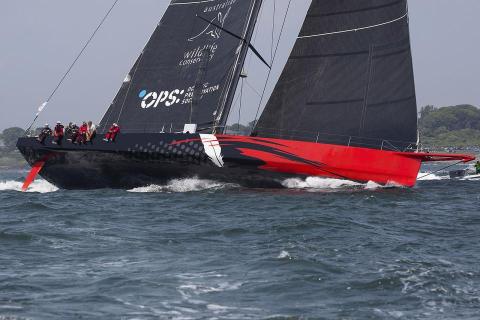Crew Overboard Procedures on Comanche
By Chuck Hawley, San Francisco Station, October 2019
Several SF Station members had the opportunity to witness a Crew Overboard practice on an entirely different scale in July of this year. Immediately prior to the start of the Transpac, the owner of Comanche, Jim Cooney, invited Bill Lee, Sally Honey, and me to witness a crew overboard drill so that we could see how the professional crew have modified existing techniques to work well with the ultralight 100’ speedster. Stan Honey, her navigator, was instrumental in putting the event together.
The technique employed by Comanche’s crew is more like a rescue on a 45’ cruising sloop than it is different.
- Initially, there is the shout of Man Overboard. The crew members immediately go to their stations. A spotter begins pointing to the Person in Water (PIW), positioning himself where he can both see, and be seen by the helmsman.
- The helmsman slows the boat down by selecting a safe but inefficient point of sail that reduces the distance sailed away from the PIW.
- Headsail(s) are immediately furled to reduce the boat’s power and to allow the boat to be brought into the wind at some point.
- Preparations are made to drop the mainsail.
- The boat is maneuvered downwind of the PIW so it can return to the PIW with the wind on the bow.
So what is different in Comanche’s technique?
- Comanche has a retractable propeller that has to be deployed before she can be operated under power.
- Comanche relies on a trained rescue swimmer (the “swimmer of the watch”) to make contact with the PIW. He has to don his wetsuit, a climber’s harness and other gear to prepare to enter the water. (Note: this is not just a brave individual, or a good swimmer, but someone who is specifically trained to survive in the water and aid people in distress. Training is vital.)
- As soon as the propeller can be engaged, the boat is brought head to wind and the mainsail is dropped into the jacklines, which have been rigged in the previous minutes.
- Using inputs from the spotter and navigator, the boat is brought abeam of the PIW, approximately one and a half mast heights away. With her 165’ mast, this distance was somewhat over 200’ on Comanche.
- The swimmer has a small diameter Spectra line attached to his harness that is kept on a spool by the mast. As he dives in and swims to the PIW, the line spools out, connecting him to the mothership.
- When the swimmer contacts the PIW, he either puts a strop around the PIW or snaps directly to the PIW’s chest harness. He then gives thumbs up to the crew.
- Rather than pulling on the bitter end of the spectra line, the crew snaps a shackle from a masthead halyard to the bight of the line and begins to hoist the halyard up the mast. This causes an inverse 1:2 mechanical advantage, which also has the effect of pulling up on the two crewmembers so that they are more likely to stay on the surface.
- When the crewmembers reach the topsides of Comanche, they are gently lifted aboard using the same spectra line.
On the day that we observed the mock rescue, the entire process took seven minutes. What was remarkable to the guests on board was the entire absence of unnecessary chatter or even raised voices. The crew either spoke in calm, relatively quiet voices or didn’t speak at all, but instead attended to their roles with quiet efficiency. The other observation was that the crew knew exactly what to do at each moment not so much because they were professional sailors, but because they had drilled on what to do and as a result there were no surprises. It was the opposite of the Chinese Fire Drill approach that many of us have witnessed in the past.
Our thanks to owner Jim Cooney, Stan Honey, and the crew of Comanche for giving us a chance to observe and record their crew overboard practice.
The Cruising Club of America is a collection of passionate, seriously accomplished, ocean sailors making adventurous use of the seas. All members have extensive offshore boat handling, seamanship, and command experience honed over many years. “School of Hard Rocks” stories, published by the CCA Safety and Seamanship Committee, are intended to advance seamanship and help skippers promote a Culture of Safety aboard their vessels





